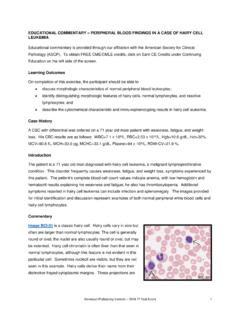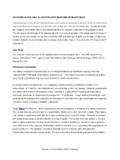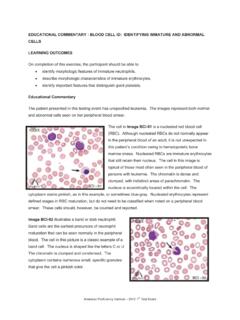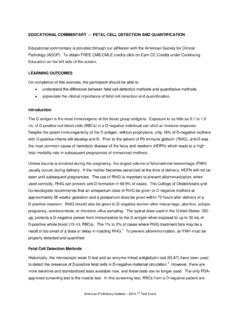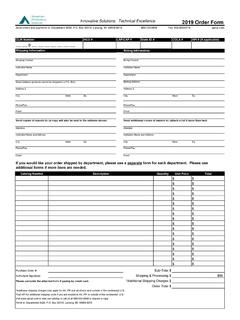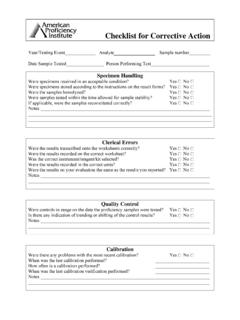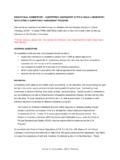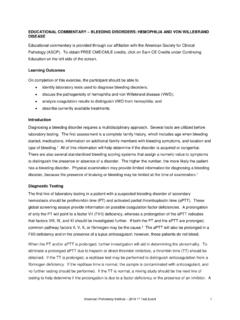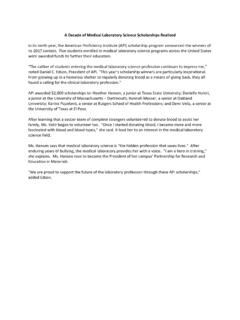Transcription of ABO Group Discrepancies - Three Case Studies
1 American Proficiency Institute 2015 3rd Test Event ABO Group Discrepancies - Three case Studies case study #1 AD is an 86-year-old man brought to the ER from an assisted living facility. He was diagnosed with acute anemia of unknown origin when his CBC revealed a hemoglobin of gm/dL with a hematocrit of 12%. A STAT type and screen for two units of blood was ordered. The patient was typed as Group B Rh Positive and his antibody screen was negative. Two units of Group B Rh Positive blood were found to be crossmatch compatible and one unit was released for immediate transfusion. Shortly after the transfusion began, the patient reported severe chest and back pain and shortness of breath. He became tachycardic and his blood pressure dropped significantly. The transfusion was stopped and samples were collected for a transfusion reaction workup. A type and screen on the post-transfusion samples was ordered.
2 Expected Results EDU-09 Post-Transfusion Red Cells, EDU-10 Post-Transfusion Serum ABO/Rh Anti-A Anti-B Anti-D A1 Cells B Cells Interpretation Pos (mf) Pos (mf) Pos Neg Pos No Type Determined mf= mixed field EDU-10 Antibody Screen: Negative case study #2 CG is a 100-year-old woman who fell and broke her hip. She has been admitted to the hospital and a type and screen is ordered. The antibody screen is negative. ABO/Rh typing was requested. Expected Results EDU-11 Red Cells, EDU-12 Serum ABO/Rh Anti-A Anti-B Anti-D A1 Cells B Cells Interpretation Pos Neg Pos Neg Neg/Weakly Pos Group A Rh Pos American Proficiency Institute 2015 3rd Test Event ABO Group Discrepancies - Three case Studies (cont.) case study #3 ES is a 41-year-old female who is scheduled for heart valve replacement surgery. A type and screen is ordered. The antibody screen is negative. ABO/Rh typing was requested.
3 Expected Results EDU-13 Red Cells, EDU-14 Serum ABO/Rh Anti-A Anti-B Anti-D A1 Cells B Cells Interpretation Pos Neg Pos Pos Pos Group A2 or A subgroup Rh Pos Discussion ABO discrepancy is a generic term for a variety of situations in which the interpretation of a patient or donor ABO grouping results is unclear. These Discrepancies occur when unexpected negative or positive reactions occur in the forward or reverse grouping. ABO Discrepancies happen for a wide variety of reasons, including technical errors, problems with red cell antigen (forward grouping), problems with serum antibodies (reverse grouping), or problems with serum and cells. Four major categories are used to Group the various types of ABO Discrepancies . 1. Weakly Reacting or Missing Antigens This discrepancy occurs when there is unexpected reactivity in the forward grouping, as occurred in case History #1. In this situation, the presence of mixed field reactivity and the history of recent transfusion and symptoms of a transfusion reaction indicate that an ABO incompatible red cell unit was transfused.
4 The pre-transfusion sample typed as B Positive and Group B units were selected for transfusion. The reverse grouping of the post transfusion sample suggests the patient is Group A and that the probable cause of this event is a sample collection error. A complete transfusion reaction investigation should be performed to conclusively determine the root cause of the sample collection error. Other Causes of Extra or Weak Reactivity in the Forward Grouping 1) Acquired B Phenomenon an uncommon ABO discrepancy that occurs only in Group A patients with diseases of the digestive tract. Enzymes produced by some gram-negative bacteria remove a part of the A antigen (specifically, the acetyl Group from the last sugar on a Group A chain, N-acetylgalactosamine), leaving behind a modified sugar, galactosamine, that makes the chain American Proficiency Institute 2015 3rd Test Event ABO Group Discrepancies - Three case Studies (cont.
5 Resemble the B antigen--the B antigen-specific sugar is galactose. This faux B antigen cross-reacts with fresh human anti-B as well as monoclonal anti-B testing reagents. 2) Subgroups of A (A3, Ax, Am, Aend, Ay, Ael) or B (B3, Bx, Bm, Bel) may react weakly or not at all. 3) Some disease states such a leukemia and Hodgkin s disease may yield weakened A and B antigen reactivity. 2. Weakly Reacting or Missing Antibodies in the Reverse Grouping The most common cause of this discrepancy is that the patient has depressed antibody production or cannot produce ABO antibodies. This patient population includes: elderly patients, as illustrated in case History #2; infants less than 6 months old; patients with hypogammaglobulinemia; hematopoietic progenitor cell transplant patients; and ABO subgroups. The investigation and resolution of this type of discrepancy includes techniques that enhance IgM reactivity such as reducing the incubation temperature.
6 Appropriate controls, such as auto-control and Group O screening cells, should be included to verify that the increased reactivity is due only to an ABO antibody and not another cold reacting antibody. Additional techniques include enzyme treatment of the reverse grouping cells and absorption/elution Studies . 3. Miscellaneous Reverse Grouping Reactivity The most common causes for these Discrepancies are: 1) Unexpected ABO isoagglutinins, as represented in case History #3. This type of discrepancy is seen in Group A2, A2B and some other subgroups of A. To resolve the discrepancy, several examples of Group A1, A2, B, and O red cells and an auto-control should be tested. If reactivity occurs with only the A1 cells, the specificity can most likely be identified as anti-A1. The patient s red cells can be typed with anti-A1 lectin (Dolichos biflorus) to determine subgroups of the A antigen. 2) Unexpected non-ABO cold reacting alloantibodies such as anti-M, anti-P1 or autoantibodies ( , anti-I).
7 American Proficiency Institute 2015 3rd Test Event ABO Group Discrepancies - Three case Studies (cont.) 4. Protein or Plasma Abnormalities Resulting in Rouleaux Formation and Pseudoagglutination Causes of this type of discrepancy include: elevated level of globulin from multiple myeloma and other disease states, elevated level of fibrinogen, and cord blood contaminated with Wharton s Jelly. Because of the potential for fatal consequences, all ABO Discrepancies must be resolved before determining a patient s ABO Group . Should a transfusion be required before the discrepancy is resolved, Group O red blood cells and Group AB plasma must be transfused. References Fung, MK (ed): Technical Manual, 18th ed. AABB, Bethesda, MD 2014. Harmening, D: Modern Blood Banking and Transfusion Practices, 6th ed. FA Davis, Philadelphia, PA 2012. This case study and antibody discussion was provided by Hemo bioscience ( ), the manufacturer of these Blood Bank proficiency samples.
8
